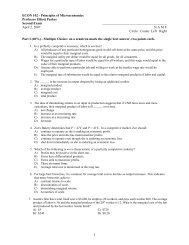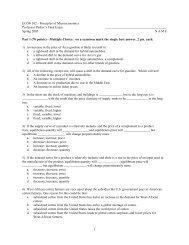ECON 102 - Principles of Microeconomics Professor Elliott Parker ...
ECON 102 - Principles of Microeconomics Professor Elliott Parker ...
ECON 102 - Principles of Microeconomics Professor Elliott Parker ...
Create successful ePaper yourself
Turn your PDF publications into a flip-book with our unique Google optimized e-Paper software.
30. In the absence <strong>of</strong> government action, polluters will pollute up to the point at which the marginal socialbenefit <strong>of</strong> pollution is:A) equal to the marginal social cost <strong>of</strong> pollution.B) zero.C) maximized.D) greater than the marginal social cost <strong>of</strong> pollution.31. There are two plants (A and B) in an industry. To reduce pollution, the government has imposedenvironmental standards forcing each plant to cut emissions by 60%. At the emissions standard, themarginal social benefit <strong>of</strong> pollution for Plant A is $500 and the marginal social benefit <strong>of</strong> pollution for PlantB is $125. The same level <strong>of</strong> pollution can be achieved at a lower cost by:A) forcing Plant A to reduce emissions and allowing Plant B to increase emissions.B) allowing both plants to pollute more.C) forcing both plants to reduce emissions.D) allowing Plant A to pollute more and Plant B to pollute less.32. Which <strong>of</strong> the following statements about environmental standards and emissions taxes is correct?A) An emissions tax is a more efficient way to reduce pollution than an environmental standard, becausean emissions tax leads to an equalization <strong>of</strong> the marginal benefit <strong>of</strong> pollution from all sources.B) An environmental standard is a more efficient way to reduce pollution than an emissions tax, becausean environmental standard can be structured to lead to an equalization <strong>of</strong> the reduction in pollutionfrom all sources.C) If an emissions tax and environmental standards lead to the same total reduction in pollution, then theywill also lead to the same reduction in pollution by individual polluters.D) It is easy to set emissions taxes at the “correct” level, since the relationship between emissions taxesand the reduction in emissions that they will induce has been extensively studied and is well-known.33. When an activity like education generates a positive externality, the:A) marginal cost <strong>of</strong> production is below the market demand curve.B) market demand curve is above the marginal social benefit curve.C) market demand curve is below the marginal social benefit curve.D) market will produce more than the efficient level <strong>of</strong> output.34. If left totally to the free market, the amount <strong>of</strong> police protection provided in a city would be _____ than it isnow, and free-riders would pay _____ for police protection.A) less; a higher price C) more; moreB) less; nothing D) more; nothing35. Common resources tend to be overused because:A) individuals tend to ignore the cost their use <strong>of</strong> the resource has on others.B) the individual marginal cost is greater than the marginal social cost.C) common resources are nonrivalrous and nonexcludable.D) property rights are well defined and enforceable.E) the marginal cost <strong>of</strong> allowing one more unit <strong>of</strong> consumption is zero.36. A good is most likely to be artificially scarce if:A) it is nonexcludable and nonrivalrous.B) the seller is a monopolist.C) it is nonexcludable but rivalrous.D) it is excludable but nonrivalrous.37. The problem created by artificially scarce goods is similar to that <strong>of</strong>:A) externalities.B) an oligopoly.C) a natural monopoly.D) Price discrimination.Page 6






